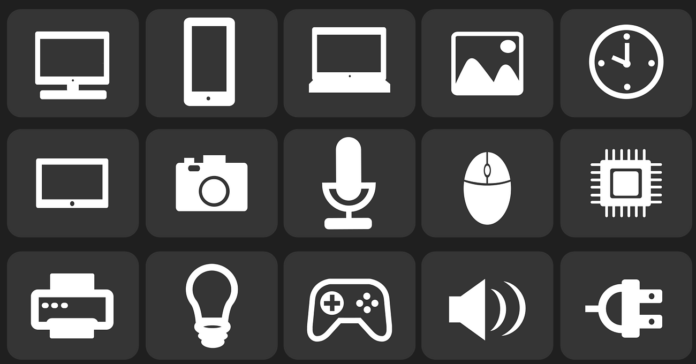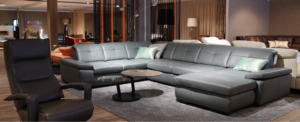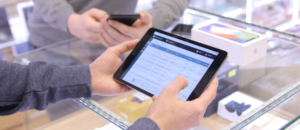A few weeks back, we covered seven ways to section up your display to show off products, announce events, or other purposes. If you’re interested in very specific screen division layouts, check out that article first! This time around, we dive in deeper and focus on specific industries and explore digital signage use to give you some starting ideas. Many of these examples can apply to multiple businesses, especially the use of data feeds, as you’ll see below.
Clothing stores
When it comes to apparel, consumers are primarily interested in color variations and sizes. A simple layout can be a rotation through best sellers. One half of the display can show off a nice combination of multiple items, with the prices for each shown off on the other half. For items which must be pre-ordered, display all available color and cut variations or similar models which might not be available right away. Shoppers could then interact with the display or scan a QR-code to place the order online.
New arrivals are also, of course, very important. Highlight upcoming collections, and do carefully thought-out campaigns for when they arrive.
Automotive dealerships
Similar to retail stores, automotive dealerships can display a slow moving rotation of a vehicle with the specifics shown on the side. Based on buyer input, isolate the most important bits of information depending on the model. This can include automatic versus manual transmission, fuel consumption, and mileage. Highlighting some more advanced or newer features could further influence buyer decisions. For example, information on driver assistance features, navigation system, connectivity, AC control, etc.
Restaurants
We’ve covered the use of digital signage in restaurants from many different angles, but they’re such an important example that we simply couldn’t skip over it! Restaurants are the perfect place to demonstrate the power of apps and digital menu boards.
Digital signage software provides a variety of ways to present food items. You can design columns of items that are easy to read, or even create menus to rotate through the visuals of specific items. Explore the digital signage apps which can unlock more opportunities.
Cosmetics and beauty stores
The world of cosmetics is all about keeping up with the seasonal preferences of shoppers. It’s about trends and providing a wide range of offers for everyone. Digital signage can show off brands which are currently in the spotlight on social media. It’s a great way to broadcast a clear message that a product product is available.
Consider ways to appeal to larger audiences. For example, highlight products and color palettes based on seasonal shifts. As skincare routines change throughout the seasons, bundle up products which work well together. Build offers based on skin types. For sensitive skin, for example, pick out the ideal make up remover, a refreshing face mask, and a moisturizer. Based on shopping behaviors and feedback, you’ll quickly segment customer types and their interests.
You could summarize products based on their variety. For example, instead of listing each individual foundation or concealer shade, make a banner that notes the wide range of skin shades which are available, informing your audience there’s something for everyone!
Home goods and furniture stores
Home goods stores rotate their special offers all the time, consistently pushing key products to the forefront. Digital signage can make the experience richer by highlighting products at the storefront displays or in store. However, it’s important to choose the right ones. Ideally, a home goods store should be aware of customer preferences by tracking what’s consistently sold throughout the year. Another approach can be to push not well selling products to see why that is. Perhaps buyers are simply unaware of the options. But if a product doesn’t sell well regardless of a discount or promotion on digital signage, the interest might simply not be there.
For furniture, consider using interactive tablets or displays. As customers commonly choose a color or variation not available on site, interactive digital displays can allow them to preview their order, helping them make more confident decisions.
In terms of displaying, show off several items at once with a price tag stamped by them. With digital signage software, you can build data feeds containing the product name, image, and price. You can then feed this data automatically into apps displaying the content. This way, you only need to select which items you want to show, and they’ll be pushed to the display. Check out the Casual Menu Board App, for example, to see how this can be done. This is only one app example, of course. There are other layouts which might suit you even better!
Jewelry stores
Highlight jewelry with stunning surrounding visuals or shots of models wearing the jewelry to give it a stronger impact. Show off the price, of course, as prices do vary in this field and customers are quite aware of a good deal when they see it. Display matching sets, or even show off similar jewelry styles which come at lower prices. This one applies mainly to high street jewelry stores, while exclusive stores may not want to disclose price.
In terms of timing the content, here you should be mindful of the events happening at a given time. Summer and early fall are perfect for weddings. Holidays such as Valentine’s Day, Christmas, and the New Year are all great opportunities for custom banners and offers.
Sports equipment stores
Following the seasons, push products based on the excitement and interest in sports. Roller blades won’t sell too well in winter, so reserve them for other seasons. Warmer or cooler clothing goes without saying. It’s all about how you represent it. Keep an eye on local activities and events, and even consider promoting them as shoppers might have an interest in them. Professional sports events such as soccer leagues or international competitions are excellent occasions to sell merchandise.
Tech and gadget stores
Smartphones, gadgets, and other techie products are very much affected by trends and public interest. For example, the latest hit in the smartphone world is the return of flip phones with a more modern touch. As it is with any trending device, buyers are always on the lookout for stores offering them. They might be indecisive when it comes to ordering them online, but seeing a big digital display in a local store letting them know it’s available is more likely to result in a closer look and eventual decision.
In terms of timing, offering speakers, phone gadgets, cases, headphones, etc. is always solid throughout the year. It all comes down to representing them. As we mentioned above, data feeds are excellent for this purpose, letting you easily import new items and displaying them with ease.
Bookstores
Depending on the size and changes in bookstores, pinpoint available genres, new releases, book sets, and so on. If the store gets crowded, you can take it a step further and show off peak traffic times, letting people organize their time better.
We mentioned data feeds, but also keep in mind that you can connect other sources to your digital signage. For example, you can build a data feed based on existing Google sheets! Learn how to do that here, and try it out for free with OnSign TV!








